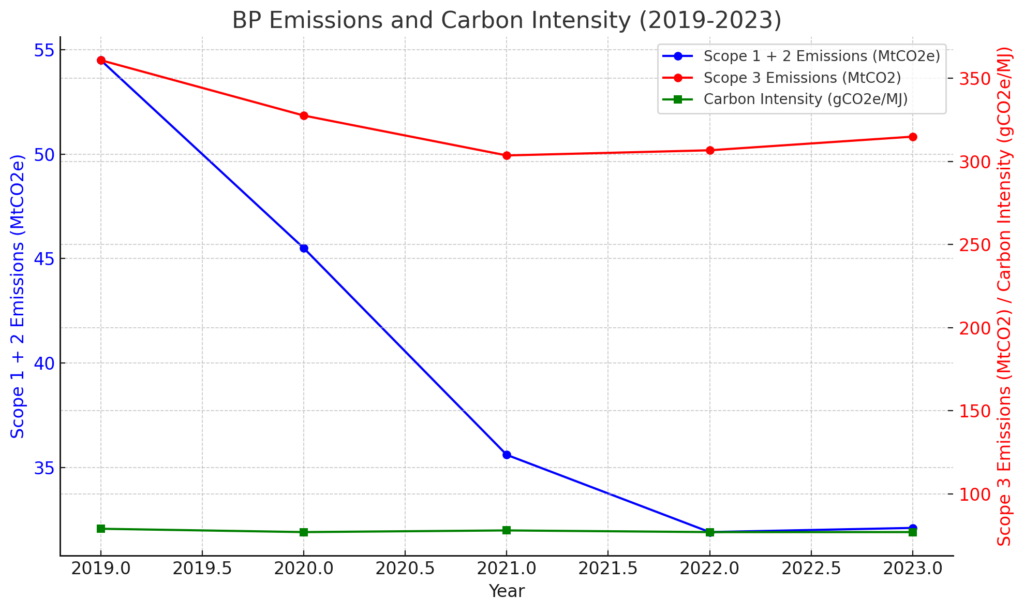- By: Ghgscore / Oil and Gas Producer / 0 Comments
Visual Data Representation
GHG Emissions analysis of BP
GHG emissions analysis evaluates a company's carbon footprint, tracking direct and indirect emissions.
Total GHG Emissions: In 2023, BP reported Scope 1 (direct) GHG emissions of 31.1 MtCO₂e and Scope 2 (indirect) emissions of 1.0 MtCO₂e. Scope 3 Emissions (emissions from the carbon in BP’s sold oil and gas products) increased to 314.9 MtCO₂ in 2023, reflecting an overall rise compared to 306.7 MtCO₂ in 2022.
In 2023, the emissions intensity for exploration, production, and LNG was 15.7 tCO₂e per thousand barrels of oil equivalent (boe) produced, a slight increase from 14.2 in 2022.
Net Zero Target: BP aims to reduce its Scope 1 and 2 emissions and achieve net zero emissions by 2050. In 2023, it made limited progress in sustainable GHG emissions reductions, with a reduction of 0.9 MtCO₂e.
Sustainable Reductions: BP has continued efforts to reduce emissions but reported fewer sustainable reductions compared to prior years (down from 1.5 MtCO₂e in 2022)
Key Contributors: The main contributors to BP’s emissions are its refining and chemicals activities (15.1 MtCO₂e) and exploration, production, and LNG operations (15.2 MtCO₂e).
Methane Emissions: Methane emissions remained steady at 0.05 Mt in 2023, showing sustained efforts to curb methane leakage.
BP’s GHG emissions reporting adheres to international standards such as the GHG Protocol. Its emissions are assured by third-party auditors like Deloitte.
The company complies with regulatory frameworks and aims to meet Science-Based Targets for GHG reductions.
Peer Comparison: BP’s carbon intensity of sold energy products (77 gCO₂e/MJ in 2023) has remained consistent with industry averages, especially for refined and gas products.
Sector Benchmarks: BP’s refining carbon intensity (92 gCO₂e/MJ) and gas products intensity (67 gCO₂e/MJ) are in line with industry norms.
Risks: BP’s continued reliance on fossil fuels poses regulatory and reputational risks as governments push for lower emissions targets. Its slight increase in GHG emissions in 2023 highlights the challenge of balancing energy production and emissions reductions.
Opportunities: BP is investing in transition growth areas like bioenergy, EV charging, and renewables. In 2023, it invested $3.8 billion in these areas.
Coming soon...
BP’s GHG emissions analysis shows steady progress in reducing emissions intensity but highlights the need for stronger efforts in sustainable reductions and renewable energy adoption. The company’s reliance on fossil fuels remains a key challenge as it transitions to net zero by 2050.
Improve Emissions Reductions: BP could accelerate its sustainable GHG reduction measures and set more aggressive targets.
Expand Renewable Energy Use: Increasing the percentage of renewable energy in its operations could significantly lower Scope 2 emissions.
Reference:
Data source for analysis:
BP. (2024). ESG Datasheet 2023. BP p.l.c. Retrieved 1 October, 2024, from here.
The GHG emissions analysis provided on GHGScore.com is intended for informational purposes only. While we strive to ensure accuracy and comprehensiveness, the data is based on publicly available information, reports, and third-party sources, which may be subject to change or revision. GHGScore.com does not guarantee the completeness or accuracy of the data, nor does it provide any warranty or endorsement of the analyzed companies.
The analysis is not intended to serve as financial, legal, or environmental advice, and users should not rely solely on this information for decision-making purposes. GHGScore.com is not responsible for any actions taken or decisions made based on the content of this site. We encourage businesses and individuals to consult with professional advisors or directly with the companies for more detailed or specific information.
By using this site, you agree to the terms of this disclaimer and acknowledge that GHGScore.com assumes no liability for any errors, omissions, or damages arising from the use of this analysis.

- Share:

